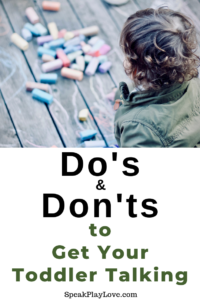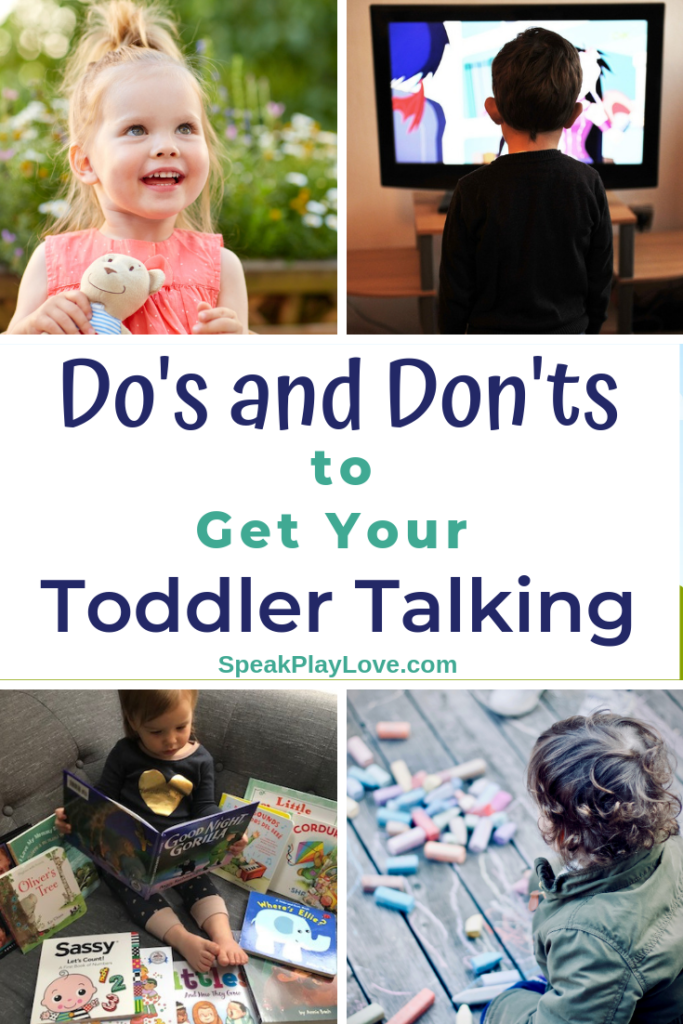
Do’s and Don’ts to Get Your Toddler Talking
When your baby is tiny, you get in the habit of doing everything for him – as you should! But if you hang on to some of the habits you started from birth, you might be doing your budding toddler a disservice.
First, let’s take a look at some of the “Don’ts” that I saw happening in a lot of houses when I worked in Early Intervention speech-language therapy services with late talkers. (And please don’t think I was immune to these habits either – I definitely caught myself doing some of these things with my own daughter!)
This post contains affiliate links, which means we could receive a commission if you click a link and purchase something that we have recommended.
Here’s the thing – it’s hard to know WHEN to stop doing some of these things. There’s no hard line for when your baby is officially a pre-toddler. And the first one is the hardest habit to break. Take a step back and see if you are doing any of these:
Don’ts: What Not to Do to Get Your Toddler Talking

1. Don’t Anticipate Her Every Need
Your newborn needed every need met by you, so you tried to anticipate what she would need before she cried/melted down – a bottle, a burp, sleep, etc. but as your baby grows, start to take a little step back to give her the chance to communicate what she needs.
Notice that I said, “communicate” rather than “talk.” That’s because as early as 6-9 months, you can start to let your baby can use gestures like pointing or pulling your hand or baby sign language to tell you what she wants. Check out this sign language video library by clicking here.
Of course, if your little one is a bit older and starting to talk, then give her some space to do that! Luckily, as her caregiver, you’ll probably have a good idea of what that thing could be, which will help as early communication isn’t always clear.
RELATED: Grab these Song Choice Cards from my Etsy shop!
2. Don’t Use “Baby Talk”
There is a term used by Speech-Language Pathologists to describe when a caregiver mimics coos and gaga sounds back to a small infant – “Mother-ease.” Using mother-ease is a wonderful way to engage with a very young infant and also involves eye contact, humming/singing. Do This! It encourages language development in very young babies.
But don’t keep using nonsense sounds as your baby gets closer to the one-year mark. You want to model full, useful words and short phrases.
I also consider “Baby Talk” to be when you use full words, but purposefully pronounce them like a young child would, “You want da widdle wabbit?”
It’s so important for babies to hear all the sounds in our language, including the harder/later-developing sounds like “r, l, and th.” So don’t deprive your baby of hearing these sounds on a regular basis.
3. Don’t Stand Over your Child while She’s playing and Give Directions
There’s a time for independent play (but supervised for safety) where you are not involved and you let your child explore toys/items. Independent play is great – sit back and enjoy this time! (or do chores nearby – let’s be realistic)
And then there’s a time for interactive play where you get down on the floor and participate. (see more about this below).
Both are great! So pick one of those and don’t get caught in the middle by telling your child HOW to play.
RELATED: Recommended Toys for Interactive Play
4. Don’t Constantly Quiz Him
Once he starts to talk a bit, you’ll want to ask, “What’s that?” constantly. It’s amazing to see what new word he’s learned recently. This is one tip that I have trouble following if I don’t remind myself and take a step back!
Now, there’s nothing wrong with finding out what words he knows, but don’t let quizzing be the only thing you do when you are out and about or reading a picture book.
Instead, keep teaching him new words and phases by narrating what you see. If he points out something, you can expand on what he says. For example if he says, “truck.” You can say, “Wow, that’s a big truck!” This way, you are keeping the conversation going and adding an extra detail (big). He doesn’t have to repeat you. This is just a way to keep the language-learning going!
5. Don’t Think “Learning” Apps, T.V. and Electronic Toys Will Teach Your Toddler to Talk
This is a tricky one because educational toys and apps sure do advertise a lot about how well they teach language concepts. And that’s the thing – they teach language concepts.
Concepts are not the same as talking. Concepts are vocabulary, grammar, ABCs, shapes, colors, etc. Talking, on the other hand, is very social and reciprocal. As caregivers, we constantly adjust how we talk to and teach our children based on so many factors – without even realizing it! You are your child’s best teacher, so please don’t think an app can replace you!
Here is a great video from the American-Speech-Language-Hearing Association (ASHA):
Looking for some toys that ARE recommended for language development? Check out this post on Interactive Learning Toys
Do’s: How to Help Your Toddler Talk

1. Teach Her New Words and Simple Phrases Just by Talking
Point out things around you or in books and tell her the name for that thing – or the name of that action, or color, etc. Try narrating what you are doing or what she is doing in child-friendly language (keep sentences short and use simple words). You don’t have to do this constantly, but when your child is interested in something, take advantage of that! Read more about how to do this with examples here.
RELATED: How to Talk to Your Toddler for Language Development
2. Wait, Wait, Wait
This takes practice. Giving extra time was one of the hardest things for parents to master when I was providing speech therapy to toddlers.
When you ask a question or you know your child wants something basic that he has the word for like “milk” or “up”. Don’t jump in and repeat the question right away or model the word he should say right away. Instead. . . wait.
I mean really wait. Count in your head for at least 3-5 seconds. Some kids need longer. I’ve been known to wait up to 15 seconds as long as the child is not getting really frustrated or distracted. This is especially true if you think your child knows the answer but has difficulty with processing speed or initiation. If you’ve really waited, then model the word and wait again. Still nothing? Say the word as you hand over the item he wants.
3. Act Confused
Instead of anticipating her every need, sometimes act confused – even if you have a good idea of what she wants. It’s all about creating opportunities for communication!
This also builds in wait time – see #2! Don’t do this to the point of her getting too frustrated. You can always jump in before the point of frustration and model a word she can say or sign language she can use.
RELATED: 9 Tips to Get Your Toddler Talking – It’s All About Creating Opportunities
4. Use your Regular Voice – But Don’t be Afraid to Get Creative!
We talked about not using “baby talk” above. So how do you talk to toddlers on their level and while keeping their attention?
Keep your sentences short-ish and don’t be afraid to act excited and animated when you talk.
Then, every once in a while, try an excited whisper! This is perfect when you are trying for a “sense of wonder.” You’ll likely get your tot’s full attention and maybe a little lean-in too!
RELATED: Grab these Song Choice Cards from my Etsy shop!
5. Get on the Floor
Interactive play, meaning you are on your child’s level – talking to him and playing with toys or items of interest, is integral for building language development.
You might plan a fun activity (like pasta threading or reading books or a sing along) but you don’t have to! Just follow his lead. If he’s interested in cars right now, play with cars. If he wants to spin around in circles, spin around with him – or at least tell him “ready, set, go!” and then talk about how dizzy he is!
RELATED: Recommended Toys to Encourage Language Development
RELATED: Pasta Threading – A Language Development and Fine Motor Activity
RELATED: 12 Songs for Encouraging Language Development
I hope these tips were helpful! Thanks for reading!
Pin It for Later!




7 Comments
Anastasija Belojedova
Dear Margaret,
I have found your posts very interesting.
Lots of good advices and ideas for kids speech.
I would like to ask you for help or you can call this advice.
I have 2,8 year old boy who talks well in mother language, witch is Russian.
We live in uk.
He is about to go to nursery and I want him to feel comfortable with kids and stuff there.
What will be your advice to teach him to start? My own language isn’t best, don’t want to teach him wrong. Maybe you have some ideas?
Thank you for your time Anastasija
Margaret
Hi Anastasija!
Learning two languages at your son’s young age is wonderful!!
When he is immersed in the new language all day at nursery school, he will pick it up so fast. It sounds like you definitely know a good amount of English judging by your writing. If you are worried about him learning the wrong grammar from your English, I think he will learn the proper way by being around native English speakers at nursery school.
Before he goes, try to teach him some important words or sentences in English that he’ll need those first few weeks (about eating, drinking, toileting, etc.) by using those terms in English in your home. You can also practice this with pretend play – you can pretend with a stuffed animal or a doll while speaking in the new language. Another thing to try is a first words book in English. He’ll pick up the rest soon enough!
One thing to note: when he is beginning to learn the new language, his native language learning might seem to slow down but this is normal and temporary. Really his brain is doing twice as much work!
Best of luck!
Margaret
Vicky
Hi Margaret,
I have a grandson who is 5-year old. At his age he is delayed in speech.
He can only say few words and he cannot complete a sentence. Please
advise what to do. Thank you.
Best regards,
Vicky
Margaret Feldmann, M.S., CCC-SLP
Hi Vicky,
Is your grandson being seen by a speech-language pathologist or speech therapist? If not, I would advise that you contact someone to have him evaluated. (If you live in the United States, that will probably be your school district – even if he has not started kindergarten yet.) If he already has a speech therapist, I would reach out to that person for customized plans on how to increase his communication at home.
You might want to start with the things that are most important to him such as food, basic needs, favorite toys/activities and help him learn those words. You can also work on sign language with him or using pictures around the house that he can point to in order to get his basic needs met. Each time he uses any way to communicate (words/gestures/pointing/sign language/pictures) model the word or a simple sentence that he can use.
I have an article about what to expect from Early Intervention (your son is a little older) but it might be useful! https://speakplaylove.com/early-intervention-speech-therapy/
Hope that helps a little!
Margaret
Sallie
Hello,
I have a son who turns 2 in about 2 months. He doesn’t say any words yet, but when he gets excited he screws and waves his hands. I have reached out to a speech therapist and am waiting for a reply, do you have any other tips in the mean time? Some people are telling me I’m crazy, that I’m freaking out for no reason but I feel like he’s behind.
Margaret Feldmann, M.S., CCC-SLP
Hi Sallie – I think you are doing the right thing by reaching out to a speech therapist or Early Intervention services if your son has no words yet. Have you read my article about Early Intervention speech therapy services yet? If you live in the U.S., that could be helpful. I’d also try something called the “expectant pause” to try to get some of those first words/communication attempts. Search in the search bar or look under the “parent” category for “early intervention” and for “expectant pause” I hope that helps! – Margaret
Sarah
These are super helpful! The tip about waiting is super important!